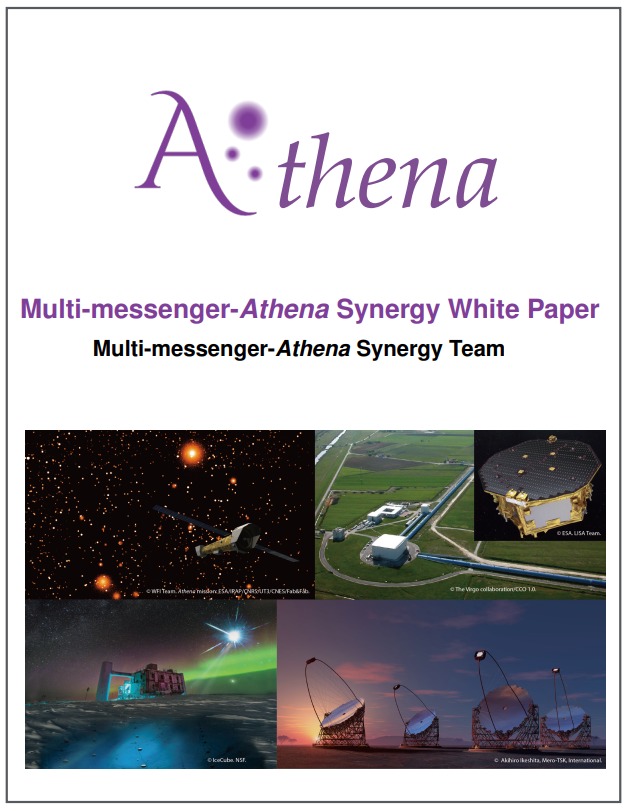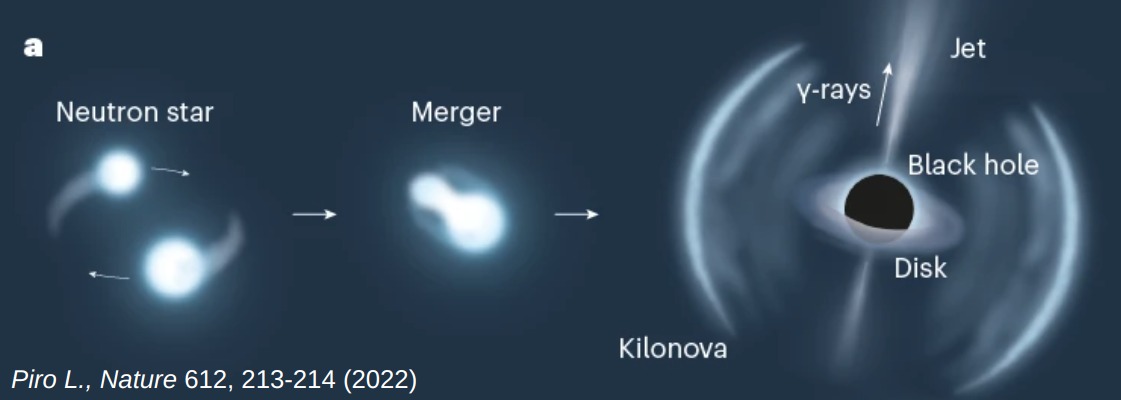Questo progetto fa parte della serie High-energy astrophysics
In detail
Athena will have scientific synergies with some of the key future multi-messenger facilities, for example detectors for ground-based observation of gravitational waves (GW), like LIGO A+, Advanced Virgo+, LISA for space-based observations of GW, IceCube and KM3NeT for neutrino observations, and CTA for very high energy observations. These synergies will be fundamental to explore new frontiers in astrophysics, cosmology and fundamental physics.

One of these is the central engine and jet physics of compact binary mergers. During such events, two compact objects, like two neutron stars or a black hole and a neutron star, merge. During the merger, we have the emission of gravitational waves. After the merger, the remnant material is expelled through winds and relativistic jets. This event produces a series of electromagnetic emissions: a kilonova, emitted by the neutron rich and hot ejected material, visible for some days in the UV, optical and infrared bands; a GRB (Gamma Ray Burst), produced by a collimated relativistic jet whose axis is inclined with a certain angle with respect to Earth, this jet emits a high energy prompt emission and an afterglow in the radio, optical and X-rays bands. A sketch of this event in the figure below.

The first ever observed event of this kind, that paved the way for multi-messenger astrophysics, is GW170817. It was detected on 17 August 2017 by the GW detectors LIGO and Virgo, the high energy satellites Fermi and INTEGRAL, and, in the following days, months and years in other bands, like X-rays by Chandra and XMM, radio by VLA, ATCA, VLBA, optical by HST.
Our team at IAPS is involved in multi-messenger astrophysics through the GAME project, Gamma-Ray Burst and GW Afterglows in the Multimessenger Era. We conducted the observations that led to the discovery of the afterglow of GW170817 and the identification of its origin, a relativistic off-axis and structured jet. We are also involved in projects that will start observations in the very near future, like the Vera Rubin Observatory (LSST) and the Einstein Probe mission.
Team
Luigi Piro, ASST, SWG.1.4, SWG.2.6, SWG.3.6
Claudio Macculi, MPWG.5.2
Simone Lotti, XCAT, MPWG.5.2, MPWG.5.3
Matteo D'Andrea, XCAT
Gabriele Minervini, Project Office Aishwarya Linesh Thakur, SWG.3.6
Lorenzo Natalucci, TWG.4, MPWG.5.1, MPWG.5.3
Alfredo Luminari, SWG.2.2, SWG.2.3
Francesca Panessa, SWG.2.3, SWG.2.4
Fiamma Capitanio, SWG.2.5
Alessandra de Rosa, SWG.2.4
Mariateresa Fiocchi, SWG.3.3, MPWG.5.3
Sergio Molinari, SWG.3.2, SWG.3.4
Ernesto Palomba, TWG.4
Gaetano Zimbardo, SWG.1.2
Useful links
Project website: https://www.the-athena-x-ray-observatory.eu/
https://www.cosmos.esa.int/web/athena
https://sci.esa.int/web/athena
http://x-ifu.irap.omp.eu/
https://www.mpe.mpg.de/ATHENA-WFI/

